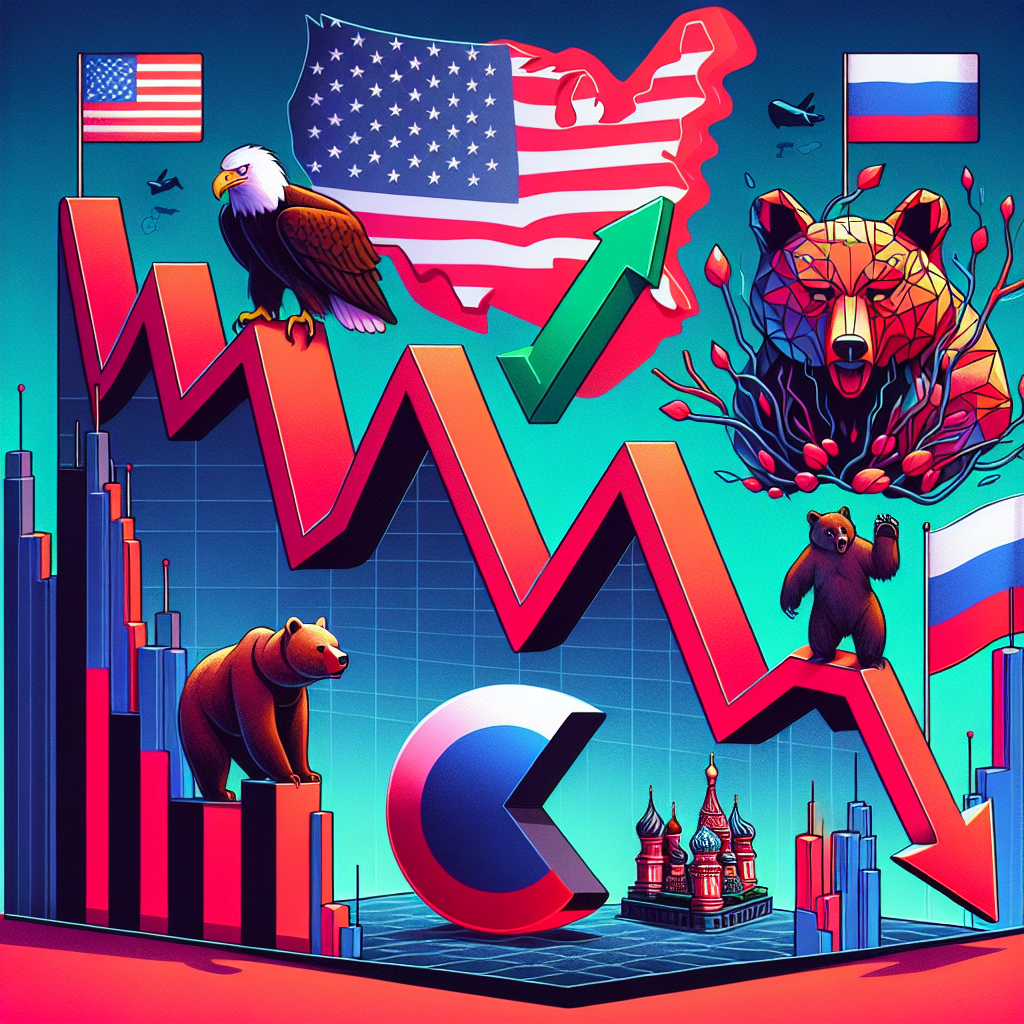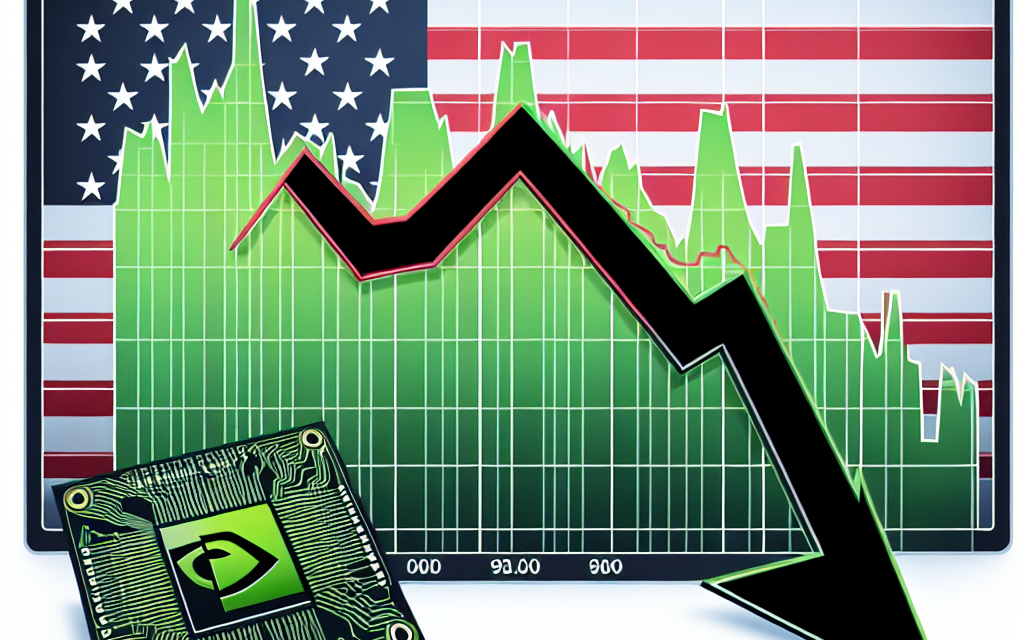“Market Turmoil: Dow Plummets 500 Points as U.S.-Russia Tensions Rise; Nvidia’s Buy Point Slips Away.”
Introduction
Amid escalating tensions between the United States and Russia, the Dow Jones futures experienced a significant drop of 500 points, reflecting heightened investor anxiety and market volatility. This decline underscores the broader impact of geopolitical uncertainties on global financial markets, as investors grapple with the potential economic repercussions of deteriorating international relations. In this turbulent environment, major technology stocks are also feeling the pressure, with Nvidia notably losing its buy point. The semiconductor giant’s stock performance is closely watched by market participants, given its influential role in the tech sector and broader market indices. As geopolitical tensions continue to unfold, market participants remain vigilant, assessing the potential implications for economic stability and investment strategies.
Impact Of U.S.-Russia Tensions On Global Markets
The global financial markets have been thrown into a state of heightened volatility as escalating tensions between the United States and Russia have led to a significant drop in Dow Jones futures, which plummeted by 500 points. This decline underscores the fragility of investor sentiment in the face of geopolitical uncertainties. As the situation between these two major powers intensifies, market participants are increasingly concerned about the potential economic repercussions, which could reverberate across various sectors and regions.
The tensions have been brewing for some time, with diplomatic relations between the U.S. and Russia becoming increasingly strained over a range of issues, including military posturing and cyber activities. These developments have not only raised the specter of further economic sanctions but have also fueled fears of a broader conflict that could disrupt global trade and economic stability. Consequently, investors are adopting a more cautious approach, seeking refuge in safer assets such as gold and government bonds, which have seen a corresponding increase in demand.
In this context, the technology sector, which has been a significant driver of market growth in recent years, is also feeling the impact. Notably, Nvidia, a leading player in the semiconductor industry, has lost its buy point, reflecting the broader uncertainty that is gripping the market. The semiconductor industry is particularly vulnerable to geopolitical tensions, given its reliance on a complex global supply chain that could be disrupted by any escalation in hostilities. Moreover, the potential for increased regulatory scrutiny and export restrictions adds another layer of risk for companies operating in this space.
As investors grapple with these uncertainties, the broader implications for the global economy are becoming increasingly apparent. The interconnected nature of today’s financial markets means that disruptions in one region can quickly spread to others, amplifying the impact of geopolitical events. For instance, European markets have also experienced increased volatility, with major indices reflecting the unease felt by investors. This interconnectedness highlights the importance of diplomatic efforts to de-escalate tensions and restore stability to the global economic landscape.
Furthermore, the energy sector is another area that could be significantly affected by the ongoing U.S.-Russia tensions. Russia is a major player in the global energy market, and any disruption to its oil and gas exports could lead to increased volatility in energy prices. This, in turn, could have a cascading effect on inflation rates and economic growth prospects worldwide. As such, policymakers and market participants alike are closely monitoring developments in this arena, aware of the potential for far-reaching consequences.
In conclusion, the drop in Dow Jones futures and the challenges faced by companies like Nvidia serve as a stark reminder of the impact that geopolitical tensions can have on global markets. As the situation between the U.S. and Russia continues to evolve, investors and policymakers must remain vigilant, prepared to respond to a rapidly changing landscape. The need for diplomatic engagement and conflict resolution has never been more critical, as the stakes extend beyond financial markets to encompass broader economic and geopolitical stability. In this uncertain environment, the ability to navigate these challenges will be crucial for ensuring sustained growth and prosperity in the years to come.
Analyzing The Dow Jones 500-Point Drop
The recent 500-point drop in Dow Jones futures has sent ripples through the financial markets, reflecting heightened investor anxiety amid escalating tensions between the United States and Russia. This significant decline underscores the sensitivity of global markets to geopolitical developments, as investors grapple with the potential economic ramifications of deteriorating international relations. The current situation has been exacerbated by a series of diplomatic confrontations and military posturing, which have raised concerns about the stability of global trade and economic growth.
In the context of these geopolitical tensions, the technology sector has not been immune to the market’s volatility. Notably, Nvidia, a leading player in the semiconductor industry, has experienced a setback as it loses its buy point. This development is particularly significant given Nvidia’s prominent role in the tech sector, where it has been a key driver of innovation and growth. The loss of its buy point suggests that investors are reassessing their positions in tech stocks, which have been among the most volatile in recent months.
The interplay between geopolitical tensions and market dynamics is complex, as investors weigh the potential impact of international conflicts on global supply chains and economic stability. The U.S.-Russia tensions have introduced a layer of uncertainty that complicates the investment landscape, prompting market participants to adopt a more cautious approach. This caution is reflected in the broader market sell-off, as investors seek to mitigate risk by reallocating their portfolios away from equities and towards safer assets.
Moreover, the current market environment is further complicated by existing economic challenges, including inflationary pressures and concerns about central bank policies. The Federal Reserve’s stance on interest rates remains a focal point for investors, as any indication of a shift in monetary policy could have significant implications for market sentiment. In this context, the Dow Jones’ 500-point drop can be seen as a reaction to a confluence of factors, with geopolitical tensions acting as a catalyst for broader market concerns.
As investors navigate this turbulent period, it is essential to consider the potential long-term implications of the U.S.-Russia tensions on global markets. While the immediate focus is on the short-term volatility, the underlying issues could have lasting effects on international trade and economic cooperation. The potential for sanctions and retaliatory measures adds another layer of complexity, as businesses and investors assess the risks associated with operating in an increasingly fragmented global economy.
In conclusion, the recent drop in Dow Jones futures highlights the intricate relationship between geopolitical developments and market dynamics. As tensions between the United States and Russia continue to escalate, investors are faced with the challenge of navigating an uncertain landscape marked by volatility and risk. The situation underscores the importance of a strategic approach to investment, as market participants seek to balance the pursuit of returns with the need to manage exposure to geopolitical risks. As the situation unfolds, it will be crucial for investors to remain vigilant and adaptable, ready to respond to new developments that could shape the future trajectory of global markets.
Nvidia’s Market Position Amid Volatility
In recent days, the financial markets have been gripped by heightened volatility, with the Dow Jones futures experiencing a significant drop of 500 points. This decline is largely attributed to escalating tensions between the United States and Russia, which have injected a fresh wave of uncertainty into global markets. Amid this turbulence, Nvidia, a leading player in the semiconductor industry, has found itself in a precarious position, losing a critical buy point that has raised concerns among investors and analysts alike.
The geopolitical tensions between the U.S. and Russia have been simmering for some time, but recent developments have intensified the situation, leading to a ripple effect across various sectors. Investors, wary of the potential economic repercussions, have reacted by pulling back from equities, seeking safer havens for their capital. This shift in sentiment has been particularly pronounced in the technology sector, where companies like Nvidia are highly sensitive to global market dynamics.
Nvidia, renowned for its cutting-edge graphics processing units (GPUs) and artificial intelligence (AI) technologies, has been a stalwart in the tech industry. However, the current market conditions have posed significant challenges. The loss of a buy point, a critical level that investors watch to gauge the stock’s potential for upward momentum, has raised red flags. This development suggests that Nvidia’s stock may face further downward pressure, at least in the short term.
Despite these challenges, it is important to recognize Nvidia’s robust market position and its strategic initiatives aimed at sustaining growth. The company has been at the forefront of innovation, driving advancements in AI, gaming, and data center technologies. These sectors continue to exhibit strong demand, providing Nvidia with a solid foundation to weather the current market volatility. Moreover, Nvidia’s recent foray into the automotive industry, with its AI-driven solutions for autonomous vehicles, underscores its commitment to diversifying its revenue streams and capitalizing on emerging opportunities.
Transitioning from the broader market context to Nvidia’s internal strategies, it is evident that the company is not resting on its laurels. Nvidia’s management has been proactive in navigating the challenges posed by supply chain disruptions and geopolitical uncertainties. By forging strategic partnerships and investing in research and development, Nvidia aims to maintain its competitive edge and drive long-term growth. These efforts are crucial in ensuring that the company remains resilient in the face of external pressures.
Furthermore, Nvidia’s financial health remains robust, with a strong balance sheet and a track record of consistent revenue growth. This financial stability provides the company with the flexibility to invest in strategic initiatives and weather short-term market fluctuations. While the loss of a buy point is a setback, it is not indicative of Nvidia’s overall market potential.
In conclusion, while the Dow Jones futures’ significant drop amid escalating U.S.-Russia tensions has cast a shadow over the financial markets, Nvidia’s market position remains fundamentally strong. The company’s commitment to innovation, strategic diversification, and financial resilience positions it well to navigate the current volatility. As investors assess the broader market landscape, Nvidia’s long-term growth prospects and strategic initiatives offer a compelling narrative that extends beyond the immediate challenges.
Strategies For Investors During Geopolitical Crises

In the ever-evolving landscape of global finance, geopolitical tensions often serve as a catalyst for market volatility, prompting investors to reassess their strategies. The recent drop of 500 points in Dow Jones futures, spurred by escalating tensions between the United States and Russia, underscores the profound impact that international relations can have on financial markets. As investors navigate these turbulent waters, it becomes imperative to adopt strategies that not only mitigate risk but also capitalize on potential opportunities.
Firstly, diversification remains a cornerstone of any robust investment strategy, particularly during periods of geopolitical uncertainty. By spreading investments across various asset classes, sectors, and geographical regions, investors can reduce their exposure to any single point of failure. For instance, while the technology sector, exemplified by companies like Nvidia, may experience volatility due to its global supply chain dependencies, other sectors such as utilities or consumer staples might offer more stability. This approach not only cushions the portfolio against sharp declines in specific areas but also positions it to benefit from growth in others.
Moreover, maintaining a long-term perspective is crucial when navigating geopolitical crises. Market fluctuations driven by international tensions are often short-lived, and reacting impulsively to daily market movements can lead to suboptimal decision-making. Instead, investors should focus on the underlying fundamentals of their investments and the broader economic outlook. Historical data suggests that markets tend to recover from geopolitical shocks, and those who remain patient are often rewarded. Therefore, a disciplined approach, grounded in long-term objectives, can help investors weather the storm.
In addition to diversification and a long-term outlook, investors should also consider the role of safe-haven assets in their portfolios. During times of heightened uncertainty, assets such as gold, U.S. Treasury bonds, and the Swiss franc often see increased demand due to their perceived stability. Allocating a portion of the portfolio to these assets can provide a buffer against market volatility and preserve capital. However, it is essential to balance this with growth-oriented investments to ensure that the portfolio remains aligned with the investor’s risk tolerance and return objectives.
Furthermore, staying informed about geopolitical developments and their potential market implications is vital. Investors should regularly consult reliable news sources and market analyses to understand the evolving situation and adjust their strategies accordingly. This proactive approach enables investors to anticipate potential risks and opportunities, rather than reacting to them after the fact. Additionally, consulting with financial advisors who have expertise in navigating geopolitical risks can provide valuable insights and guidance.
Finally, it is important for investors to remain adaptable and open to revising their strategies as new information emerges. Geopolitical crises are inherently unpredictable, and the ability to pivot in response to changing circumstances can be a significant advantage. This might involve rebalancing the portfolio, adjusting asset allocations, or exploring alternative investment vehicles that offer better risk-adjusted returns in the current environment.
In conclusion, while geopolitical tensions such as those between the U.S. and Russia can create significant market volatility, they also present opportunities for astute investors. By employing strategies that emphasize diversification, long-term planning, safe-haven assets, informed decision-making, and adaptability, investors can navigate these challenges effectively. Ultimately, a well-considered approach can not only protect against downside risks but also position investors to capitalize on the eventual market recovery.
Historical Market Reactions To International Conflicts
Throughout history, financial markets have often reacted with volatility to international conflicts, reflecting the uncertainty and potential economic repercussions that such events can bring. The recent drop of 500 points in Dow Jones futures amid escalating U.S.-Russia tensions is a stark reminder of this pattern. As geopolitical tensions rise, investors frequently reassess their risk exposure, leading to fluctuations in stock prices and market indices. This phenomenon is not new; historical precedents provide insight into how markets have responded to similar situations in the past.
For instance, during the Cuban Missile Crisis in 1962, the stock market experienced significant volatility as the world stood on the brink of nuclear war. Investors, gripped by fear and uncertainty, reacted by selling off stocks, leading to a sharp decline in market indices. However, once the crisis was resolved, markets rebounded, demonstrating a pattern of initial panic followed by recovery. This cycle of fear and recovery is a common theme in market reactions to geopolitical tensions.
Similarly, the Gulf War in the early 1990s saw a dramatic impact on financial markets. Initially, the uncertainty surrounding the conflict led to a decline in stock prices. However, as the war progressed and the outcome became more predictable, markets began to stabilize and eventually recover. This pattern underscores the importance of clarity and resolution in calming investor nerves and restoring market confidence.
In more recent history, the annexation of Crimea by Russia in 2014 also led to market turbulence. The geopolitical uncertainty and potential for economic sanctions against Russia caused investors to reevaluate their positions, resulting in a temporary dip in global markets. However, as the situation evolved and the immediate threat of further escalation diminished, markets gradually regained their footing.
The current situation, with Dow Jones futures dropping 500 points due to U.S.-Russia tensions, echoes these historical patterns. Investors are once again faced with uncertainty, prompting a reevaluation of risk and a shift towards safer assets. This reaction is compounded by the fact that major companies, such as Nvidia, are losing their buy points, further contributing to market instability. Nvidia’s situation highlights how individual companies can be affected by broader geopolitical issues, as investors become more cautious and selective in their investment choices.
In navigating these turbulent times, it is crucial for investors to remain informed and vigilant. Understanding historical market reactions to international conflicts can provide valuable context and help investors make more informed decisions. While the immediate future may seem uncertain, history suggests that markets have a remarkable ability to adapt and recover once clarity is restored.
In conclusion, the drop in Dow Jones futures amid escalating U.S.-Russia tensions is a reflection of historical market behavior in response to international conflicts. By examining past events, investors can gain insights into potential market trajectories and better prepare for the challenges ahead. As geopolitical tensions continue to evolve, maintaining a long-term perspective and focusing on fundamental economic indicators can help investors navigate the complexities of the current market environment.
Future Projections For The Dow Jones Index
The Dow Jones Industrial Average, a key barometer of the U.S. stock market’s health, recently experienced a significant drop of 500 points, reflecting heightened investor anxiety amid escalating tensions between the United States and Russia. This decline underscores the sensitivity of global markets to geopolitical developments, as investors grapple with the potential economic ramifications of deteriorating international relations. The current situation has prompted market analysts to reassess their future projections for the Dow Jones Index, taking into account the complex interplay of geopolitical factors, economic indicators, and corporate performance.
The recent downturn in the Dow Jones futures can be attributed to a confluence of factors, with the U.S.-Russia tensions at the forefront. As diplomatic relations between the two nations become increasingly strained, concerns over potential economic sanctions and their impact on global trade have intensified. Investors are particularly wary of the ripple effects that such geopolitical conflicts can have on global supply chains, energy prices, and overall market stability. Consequently, the uncertainty surrounding these developments has led to a more cautious approach among market participants, who are now reevaluating their investment strategies in light of these evolving dynamics.
In addition to geopolitical concerns, the performance of individual companies within the index also plays a crucial role in shaping future projections for the Dow Jones. A notable example is Nvidia, a leading technology company that recently lost its buy point, further contributing to the index’s decline. Nvidia’s performance is often seen as a bellwether for the technology sector, and its recent struggles have raised questions about the broader industry’s resilience in the face of economic headwinds. As technology stocks have been a significant driver of market gains in recent years, any signs of weakness in this sector can have a pronounced impact on the overall trajectory of the Dow Jones.
Moreover, the current economic landscape presents additional challenges that could influence future projections for the index. Inflationary pressures, interest rate hikes, and supply chain disruptions continue to pose significant risks to economic growth and corporate profitability. As central banks around the world navigate the delicate balance between curbing inflation and supporting economic recovery, their policy decisions will undoubtedly have far-reaching implications for the stock market. Investors are closely monitoring these developments, as any shifts in monetary policy could alter the investment landscape and affect the future direction of the Dow Jones.
Despite these challenges, it is important to recognize that the stock market is inherently cyclical, and periods of volatility are not uncommon. Historically, the Dow Jones has demonstrated resilience in the face of geopolitical and economic uncertainties, often rebounding as conditions stabilize and investor confidence is restored. While the current environment presents a complex set of challenges, it also offers opportunities for investors who are able to navigate the volatility and identify undervalued assets with strong growth potential.
In conclusion, the recent drop in Dow Jones futures amid escalating U.S.-Russia tensions highlights the intricate relationship between geopolitical developments and market performance. As investors assess the potential impact of these tensions, along with other economic factors, future projections for the Dow Jones Index remain uncertain. However, by maintaining a long-term perspective and staying informed about the evolving landscape, investors can better position themselves to capitalize on opportunities and mitigate risks in this dynamic environment.
Evaluating Tech Stocks In Uncertain Times
In the ever-volatile world of stock markets, recent developments have sent ripples through the financial community, particularly affecting tech stocks. The Dow Jones futures recently experienced a significant drop of 500 points, a movement largely attributed to escalating tensions between the United States and Russia. This geopolitical friction has injected a fresh wave of uncertainty into global markets, prompting investors to reassess their portfolios and strategies. Amidst this backdrop, tech stocks, often seen as a barometer for market sentiment, have come under scrutiny. Notably, Nvidia, a leading player in the semiconductor industry, has lost its buy point, raising questions about the stability and future prospects of tech investments in these uncertain times.
The decline in Dow Jones futures serves as a stark reminder of how sensitive markets are to geopolitical events. The U.S.-Russia tensions, characterized by diplomatic standoffs and economic sanctions, have created an environment of unpredictability. Investors, wary of potential economic repercussions, have reacted by pulling back from riskier assets, including tech stocks. This cautious approach is understandable, given that tech companies often rely on global supply chains and international markets, making them particularly vulnerable to geopolitical disruptions.
Nvidia’s recent loss of its buy point is emblematic of the broader challenges facing the tech sector. As a company at the forefront of innovation in graphics processing units (GPUs) and artificial intelligence (AI), Nvidia has been a favorite among investors seeking growth opportunities. However, the current market conditions have prompted a reevaluation of its stock. The loss of the buy point suggests that investors are becoming more discerning, focusing on fundamentals and long-term viability rather than short-term gains. This shift in investor sentiment underscores the need for tech companies to demonstrate resilience and adaptability in the face of external pressures.
In this climate of uncertainty, evaluating tech stocks requires a nuanced approach. Investors must consider a range of factors, including geopolitical risks, regulatory changes, and technological advancements. While the tech sector has historically been a driver of economic growth, its future trajectory is not immune to external shocks. Therefore, a comprehensive analysis of individual companies, their competitive positioning, and their ability to navigate challenges is essential for making informed investment decisions.
Moreover, diversification remains a key strategy for mitigating risks associated with tech stocks. By spreading investments across different sectors and geographies, investors can reduce their exposure to any single market or geopolitical event. This approach not only helps in managing risk but also provides opportunities to capitalize on growth in other areas of the economy.
In conclusion, the recent drop in Dow Jones futures and Nvidia’s loss of its buy point highlight the complexities of investing in tech stocks during uncertain times. While geopolitical tensions and market volatility present challenges, they also offer opportunities for those willing to conduct thorough research and adopt a strategic approach. As the global landscape continues to evolve, staying informed and adaptable will be crucial for investors seeking to navigate the intricacies of the tech sector. By balancing risk and reward, and maintaining a long-term perspective, investors can position themselves to weather the storm and potentially benefit from the innovations and growth that the tech industry promises.
Q&A
1. **What caused the Dow Jones Futures to drop 500 points?**
The drop was caused by escalating tensions between the U.S. and Russia.
2. **How did the U.S.-Russia tensions impact the stock market?**
The tensions led to increased market volatility and uncertainty, causing a significant drop in futures.
3. **Which major company lost a buy point amid the market drop?**
Nvidia lost a buy point during the market downturn.
4. **What is a ‘buy point’ in stock market terms?**
A buy point is a specific price at which a stock is considered to be a good purchase opportunity, often identified through technical analysis.
5. **How do geopolitical tensions typically affect stock markets?**
Geopolitical tensions often lead to market instability, as investors react to potential economic impacts and uncertainties.
6. **What sectors are most affected by geopolitical tensions like those between the U.S. and Russia?**
Sectors such as energy, defense, and technology can be significantly affected due to their sensitivity to international relations and trade.
7. **What strategies might investors use during times of geopolitical tension?**
Investors might diversify their portfolios, seek safe-haven assets like gold, or adjust their positions to mitigate risk during such times.
Conclusion
The Dow Jones futures experienced a significant drop of 500 points due to escalating tensions between the U.S. and Russia, which has heightened market uncertainty and investor anxiety. This geopolitical strain has contributed to a broader market sell-off, affecting various sectors. Additionally, Nvidia’s stock lost its buy point, indicating a potential shift in investor sentiment and market dynamics for the tech giant. The combination of geopolitical tensions and specific stock performance issues underscores the volatility and sensitivity of the current market environment.





